
Created by Ian Smith, updated 13th October 2007
ST 837-1027 The Tilling STs (Total 191) 2ST7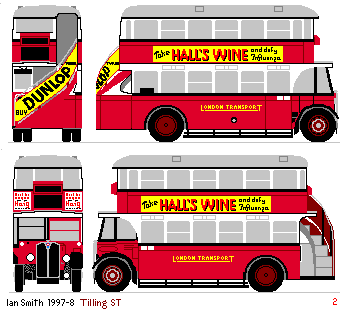 Most of these buses were built in 1930-31 for Thomas Tilling (London).
(A similar batch was built for Tillings Brighton, including four that were transferred to Tillings London
before the compulsory purchase by London Transport in 1933.)
They had 52-seat outside staircase bodies with six bays and balloon roof,
built by Dodson or Tilling.
Compared with the other Regents going into service these bodies were quite old-fashioned.
They retained the open staircase, and initially had board displays at front and rear.
These were soon replaced by a very inadequate single-line number/final destination roller blind in a protruding box,
at both front and rear. Livery was Tilling red and white, with a silver roof,
with very prominent Thomas Tilling fleetnames.
Most of these buses were built in 1930-31 for Thomas Tilling (London).
(A similar batch was built for Tillings Brighton, including four that were transferred to Tillings London
before the compulsory purchase by London Transport in 1933.)
They had 52-seat outside staircase bodies with six bays and balloon roof,
built by Dodson or Tilling.
Compared with the other Regents going into service these bodies were quite old-fashioned.
They retained the open staircase, and initially had board displays at front and rear.
These were soon replaced by a very inadequate single-line number/final destination roller blind in a protruding box,
at both front and rear. Livery was Tilling red and white, with a silver roof,
with very prominent Thomas Tilling fleetnames.
The first (ST 837) went into service at Tillings Bromley (TB) on 27 June 1930 for route 36.
Bromley was one of three garages in south-east London owned by the General but operated by Tillings.
The others were Catford (Tillings Lewisham) and South Croydon (Tillings Croydon).
These too received the new STs
for a variety of important routes, which Tillings operated:
ST922 at Chobham in April 2007 wears destination blinds and boards for the 59.
London TransportThe Tilling STs came to the LPTB on 1st October 1933 after a long compensation wrangle that had delayed their acquisition by London Transport after the July 1933 vesting day. The Tilling and Dodson bodies on the Tilling STs proved not as strong as the Chiswick-designed variety, and LT was conscious of their antiquated appearance as open-staircase buses. So by the end of the thirties they were targeted as early replacees by the new RTs, along with the open staircase LTs. Unfortunately major events in Europe delayed the arrival of their replacements by half a dozen years. The War YearsAt the start of the war the whole class was immediately placed in store because of their petrol engines. They suffered badly. Many were destroyed or badly damaged in store at Leyton garage, or in store at Bull Yard, Peckham. Some bodies were scrapped and the chassis used for armoured personnel carriers for the Home Guard on the South Coast. Other buses had a spell with the Home Guard, used as guard-rooms at garages to prevent sabotage from the expected German paratroops. Some reappeared in service as the requirement for public transport increased enormously, or when emergencies required their relicensing, such as the destruction at Croydon Garage. Even later in the war they were unlucky, suffering in the cruise missile attack on Elmers End Garage in 1944, and the ballistic missile attack on Upton Park in 1945. Whether their almost-empty petrol tanks contributed to the conflagrations is a matter for speculation.Almost all the survivors were loaned to other companies throughout the UK, some staying in the provinces for a few months and some for several years. Some companies even seemed reluctant to send them back once hostilities had ceased! One was equipped with a gas trailer for operation in Coventry, but this gave rise to complaints about smells because of the open nature of the rear on both decks. Post-War: unwanted returneesPost-war the heavy traffic demand meant that some had to go back into public service, in between spells as trainers. They were now scattered around the LT system rather than concentrated in the south-east, despite their totally non-standard destination blind requirements, which resulted in a host of sticky labels.. The official excuse for the scattering was conductress' sensibilities about skirts on open staircases - although this didn't affect the concentration of equally-open LTs! The STs were often used as spare buses and rush-hour extras, and kept away from the roving eyes of the Men from the Ministry, as their bodywork often sagged like bananas. They began to appear with a variety of vertical body straps and steel cross-plates at the waist-rail joints, in an attempt to hold them together. They were obviously considered too far gone to be sent for body rebuilds by outside contractors. They were high priority for replacement as the utilities and then the RTs became available. One was converted to a single-deck mobility bus, with wheelchair ramp, at the behest of the British Legion, presumably for use with disabled servicemen. Service fleet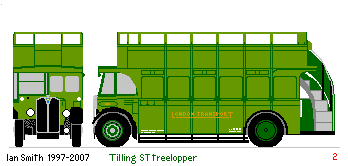
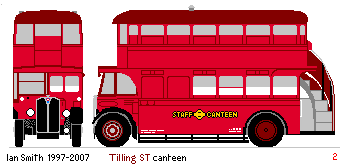 Four were converted to tree-loppers for the service fleet (ST985, ST1001, ST865 and ST870
became 647J, 648J, 650J and 651J, although 648J had its Tilling body replaced by a Lewis one before conversion.
These tree-loppers replaced NS conversions, two in autumn 1943, two more in autumn 1945.
These received Chiswick Green livery when conditions allowed, and lasted until 1953,
when they gave way to Country STL conversions.
Four were converted to tree-loppers for the service fleet (ST985, ST1001, ST865 and ST870
became 647J, 648J, 650J and 651J, although 648J had its Tilling body replaced by a Lewis one before conversion.
These tree-loppers replaced NS conversions, two in autumn 1943, two more in autumn 1945.
These received Chiswick Green livery when conditions allowed, and lasted until 1953,
when they gave way to Country STL conversions.
Six other Tilling STs were converted after the war into mobile canteens, replacing ancient NS vehicles in
giving succour to the needy (ie tea and meals to crews). ST888, ST969, ST867, ST917, ST951 and ST922
became 699J - 693J. They worked at a variety of locations where crews needed refreshment,
including some garages, such as Putney, Windsor, Cricklewood, Kingston and Streatham.
Other famous locations were the Royal Forest Hotel at Chingford and the bus stance at Belmont.
They worked alongside the new semi-trailer canteens, and lasted until 1952-55.
PreservationOne of the canteens, ST922, went on to perform the same duty for British Road Services, before falling by the wayside. Discovered by Prince Marhall, ST 922 was resurrected and restored to magnificent service condition. Original-pattern Tilling moquette was located on a foot-stool in a house in Bromley, where unfaded, unworn material was found tucked underneath. New material was made to match. The restored bus was then returned to service in Central London! A special Vintage service 100 ran during several summer seasons, carrying visitors to and from the LT Museum in Covent Garden. Now ST 922 is preserved in working order at Cobham Bus Museum by the London Bus Preservation Trust.ST922 in preservation at Cobham, October 1997. Photos by Ian Smith.In the summer of 2016 ST922 was repainted in Tilling colours, of deeper red, white band, white upper window surrounds and silver roof, in time to appear at the Bromley Garage open day in August. The sidelights were restored to their original high position, and the front number plate restored to its position above the cab/canopy.In its new Tilling livery, ST922 at Brooklands at the London Bus Musum Open Day in April 2017.STs acquired by LPTB from IndependentsA number of STs (ie short wheelbase Regents) had been bought by small operators in the London Area, and were taken over with the companies when the London Passenger Transport Board was formed following the London Transport Act. They had a variety of bodies, so remained distinct despite the usual London practice of swapping bodies during overhaul. As they all featured externally-illuminated route-boards they were all withdrawn on the outbreak of war, as not being in compliance with blackout regulations. Presumably it was not deemed worthwhile, with the shortage of crews attendant upon call-up, to fit them with roller blinds.ST 1028 ex Chariot (Total 1) 2/2ST81930 chassis, 53 seat, 5 bay Birch Bros body, outside staircase, stencil boards.This one came to LPTB in 1933, and was allocated first to Camberwell (Q) and then to Croydon (TC) until withdrawn on the outbreak of war due to blackout restrictions. The body was destroyed by air-raid on Bull Yard, Peckham in October 1940 , but the chassis survived and was sold to the Ministry of Defence for use under a Home Guard Armoured Car. ST 1029 ex Empire (Total 1) 3/2ST8/154 seat 5 bay Dodson body, outside staircase, stencil boards.This one also came to LPTB in 1933, and was also allocated to Camberwell and then Croydon, until withdrawn on outbreak of war due to blackout restrictions. It was stored at Windsor, and later loaned to West Monmouthshire Omnibus Board and then Rhondda Transport. It was scrapped at Chiswick in June 1946. ST 1030 ex Pro Bono Publico, Total 1, 4/2ST8/254 seat 6 bay Dodson body, outside staircase, stencil boards.ST1030 came to LPTB in 1933, and was allocated to Camberwell (Q), and then then Croydon (TC) until it was withdrawn on the outbreak of war (due to blackout restrictions). It was destroyed by the air-raid on Bull Yard, Peckham, in October 1940. ST 1031 ex Pembroke, Total 1, 5/2ST8/353 seat 5 bay Birch body, outside staircase, stencil boards.This too came to LPTB in 1933, and was allocated to Croydon (TC) until withdrawn on outbreak of war due to blackout restrictions. It too was destroyed by that air-raid in October 1940.
|
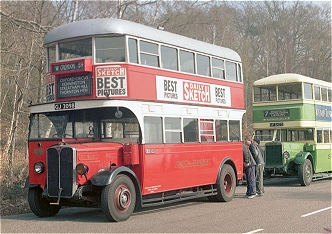
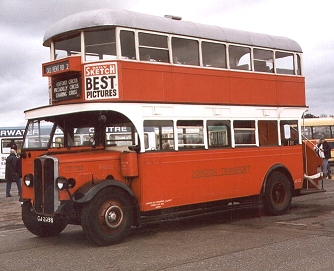
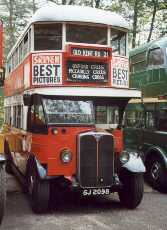

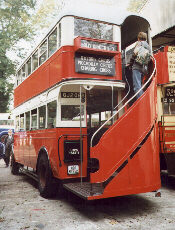
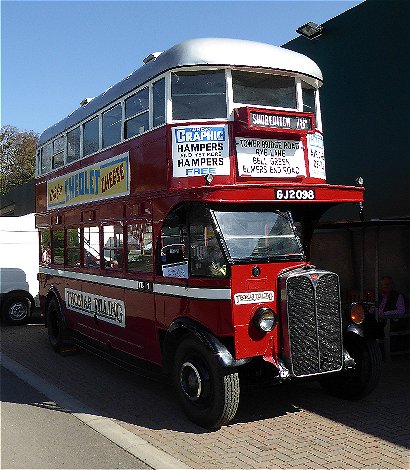
 Bus Stop
Bus Stop ST index.
ST index. bus histories
bus histories standard STs.
standard STs. Tillings.
Tillings.